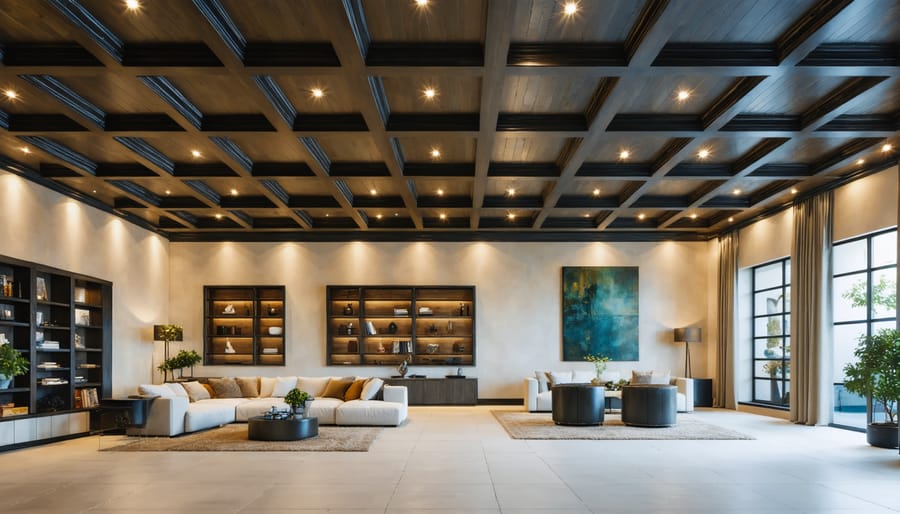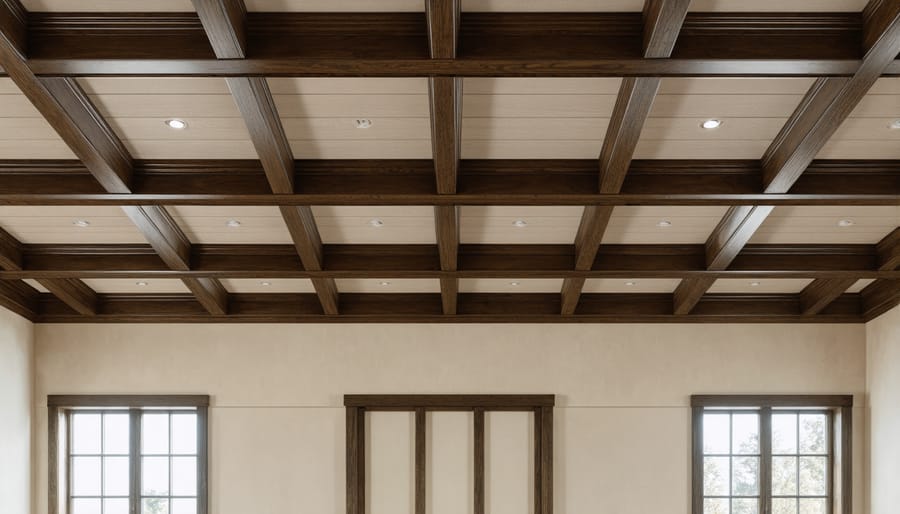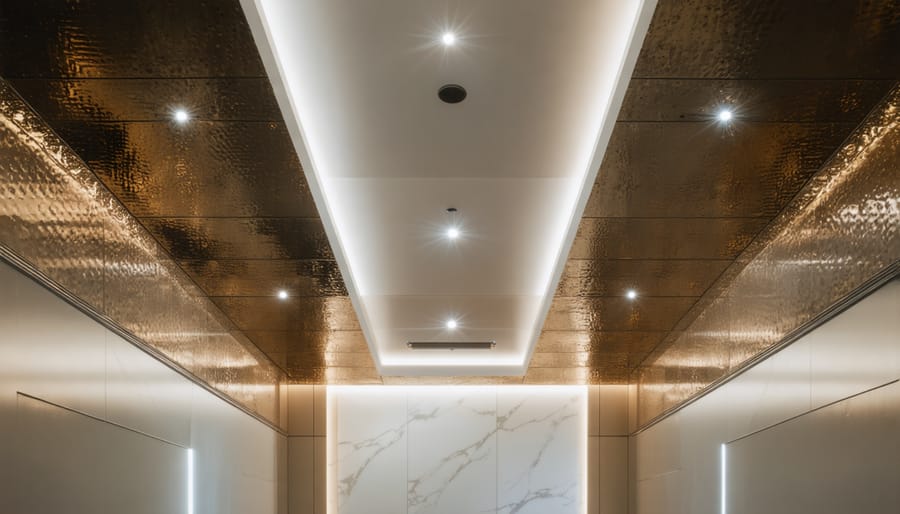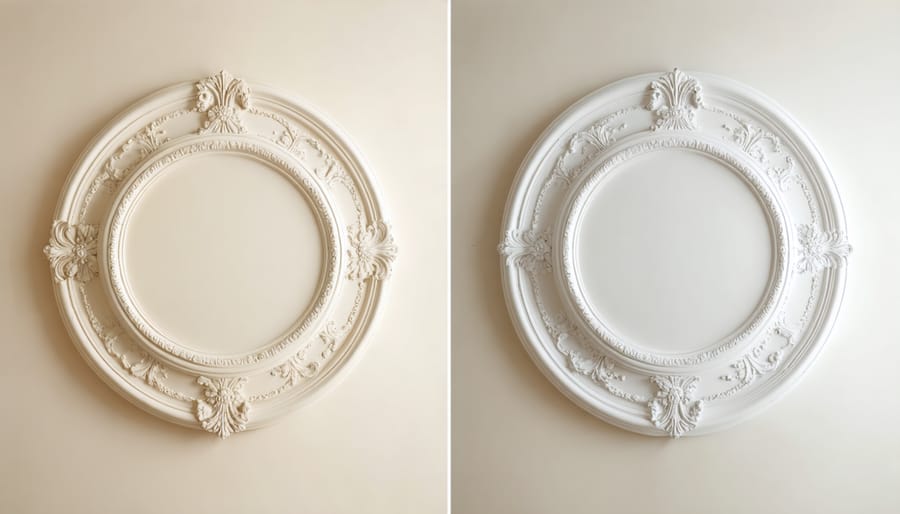
Transform Your Room with These Eye-Catching Ceiling Ideas
Transform your overlooked ceiling into a striking architectural feature with bold, innovative treatments that command attention. From intricate coffered patterns to dramatic suspended elements, modern stunning ceiling designs elevate any room from ordinary to extraordinary. Whether you’re seeking a weekend DIY project or planning a complete architectural overhaul, today’s ceiling treatments offer endless possibilities for creating visual impact overhead. Beyond traditional crown molding and basic paint, contemporary options like geometric wood panels, stretched fabric systems, and integrated LED lighting transform your ceiling into a dynamic design element that enhances the entire space. This guide explores practical, innovative ceiling treatments that work for any budget and skill level, helping you maximize the untapped potential of your home’s “fifth wall.”
Architectural Ceiling Treatments
Coffered and Tray Ceilings
Coffered and tray ceilings add architectural interest and depth to any room, creating a stunning visual impact that draws the eye upward. These dimensional designs have evolved from their classical roots in Roman architecture to become versatile options for modern homes.
Coffered ceilings feature a grid pattern of recessed panels, typically in squares or rectangles, creating a sophisticated waffle-like appearance. While traditionally crafted from hardwood, modern variations incorporate lightweight materials like MDF or foam, making them more accessible for DIY installations. The depth of these panels can vary from subtle 4-inch recesses to dramatic 12-inch drops, allowing homeowners to customize the effect based on their room height and preferences.
Tray ceilings, also known as inverted or recessed ceilings, feature a central section that’s raised above the surrounding perimeter. This stepped design can be enhanced with crown molding, LED strip lighting, or decorative paint treatments. A popular modern twist involves creating multiple levels or adding curved transitions between the levels, softening the traditional geometric look.
Both styles can be customized to match any décor theme. For contemporary spaces, clean lines and monochromatic color schemes create subtle sophistication. Traditional rooms benefit from ornate moldings and two-tone paint treatments. Consider integrating smart lighting systems into these dimensional spaces to highlight their architectural details and create adjustable ambiance.

Exposed Beams and Rafters
Exposed beams and rafters transform an ordinary ceiling into an architectural masterpiece, adding character and visual interest to any space. This rustic-meets-industrial treatment works particularly well in both contemporary urban lofts and traditional country homes, creating an immediate focal point that draws the eye upward.
Natural wooden beams offer warmth and timeless appeal, especially when preserved in their original state with visible grain patterns and natural imperfections. For a more modern look, painted or steel beams provide industrial sophistication while maintaining structural authenticity. The contrast between exposed beams and the ceiling surface creates depth and dimension, making rooms feel larger and more architecturally significant.
While some homes naturally feature these elements, you can also add decorative beams to achieve the same effect. Lightweight faux wood beams, crafted from high-density polyurethane, offer an affordable alternative that’s easier to install and maintain. These synthetic options come in various finishes, from rough-hewn oak to weathered barnwood, allowing you to match your desired aesthetic.
When incorporating exposed beams, consider the spacing and pattern carefully. Traditional parallel arrangements create a sense of order, while cross-beam patterns add complexity and visual interest. For maximum impact, ensure proper lighting that highlights the beams’ texture and creates dramatic shadows, enhancing the overall architectural effect.
Creative Surface Treatments
Wallpaper and Paint Techniques
Transform your ceiling into a stunning focal point with creative paint techniques and wallpaper applications. A simple color change can dramatically alter your room’s atmosphere – try soft blues to create the illusion of sky or deep, rich hues for a cozy, intimate feel. For a subtle effect, consider using paint that’s two shades lighter than your wall color.
Wallpaper has made a remarkable comeback, especially for ceiling applications. Modern peel-and-stick options make installation much more manageable for DIY enthusiasts. Consider metallic patterns to reflect light and add depth, or bold geometric designs to create visual interest. Natural-themed patterns like leaves or clouds work particularly well overhead.
For those seeking texture, try specialty finishes like suede or metallic paint. These treatments catch light differently throughout the day, creating dynamic visual effects. Stenciling is another fantastic option – use simple repeated patterns for a custom look without the commitment of wallpaper.
Don’t forget about color blocking and stripes. Painting straight lines or geometric shapes on your ceiling can make rooms appear larger or cozier, depending on your design choices. For a truly unique touch, consider glow-in-the-dark paint for star patterns in bedrooms or children’s rooms.
Textured Finishes
Textured finishes can transform an ordinary ceiling into a stunning focal point, much like creative wall covering ideas can enhance vertical surfaces. The most popular texturing methods include knockdown, orange peel, and popcorn textures, each creating distinct visual effects that add depth and character to your space.
Knockdown texture offers a sophisticated, Mediterranean-inspired look with its subtle, flattened peaks and valleys. This finish is particularly effective in hiding minor ceiling imperfections while creating an elegant, understated pattern that works well in both traditional and contemporary settings.
Orange peel texture provides a gentle, subtle surface variation that resembles its namesake fruit’s skin. It’s an excellent choice for modern homes, offering just enough texture to add interest without overwhelming the space. This finish is also remarkably forgiving when it comes to ceiling repairs.
For those seeking more dramatic impact, skip trowel texturing creates an artistic, hand-crafted appearance with irregular patterns that catch and play with light throughout the day. This technique requires more skill but delivers stunning results that can make your ceiling truly unique.
Newer texturing options include metallic-infused finishes and dimensional patterns that can be applied using specialized rollers, making them perfect for DIY enthusiasts looking to create custom effects without professional help.
Metallic and Reflective Materials
Metallic and reflective materials can transform an ordinary ceiling into a stunning focal point that amplifies light and creates the illusion of greater height. Mirrors are particularly effective, whether installed as individual panels or as a continuous surface. When strategically placed, mirrored ceiling sections can reflect natural light from windows, making rooms feel significantly brighter and more spacious.
Metallic tiles and panels offer another dramatic option, available in materials like brushed aluminum, copper, and stainless steel. These can be arranged in various patterns, from a simple grid to more complex geometric designs. For a more subtle approach, metallic paint finishes and gilding techniques can add a sophisticated shimmer without overwhelming the space.
One popular trend is using metal leaf applications – copper, silver, or gold – to create artistic ceiling designs. This technique works especially well in powder rooms or dining areas where intimate lighting can highlight the reflective qualities of the material.
When working with reflective surfaces, consider the room’s lighting carefully. LED strips or strategically placed spotlights can enhance the dramatic effect, while dimmer switches allow for mood adjustment. For DIY installations, lightweight metallic ceiling tiles are available in easy-to-install options that attach directly to existing surfaces with adhesive or simple mounting systems.
Remember that less is often more with reflective materials – consider using them as accent features rather than covering entire ceiling spans to avoid overwhelming the space.

Lighting Integration
Recessed and Cove Lighting
Recessed and cove lighting offer elegant solutions for transforming ordinary ceilings into stunning architectural features. These hidden lighting techniques create soft, ambient illumination that can make rooms feel larger and more sophisticated while highlighting architectural details.
Recessed lighting involves installing fixtures within the ceiling cavity, creating a clean, modern look without visible hardware. These lights can be strategically placed to create pools of light for task areas or to wash walls with illumination. For maximum impact, consider installing dimmable LED recessed lights that can be adjusted to suit different moods and activities.
Cove lighting takes a more architectural approach by concealing light strips within soffit details or crown molding. This creates a gentle upward glow that bounces off the ceiling, producing a warm, diffused effect that adds depth and drama to any room. The best part? You can achieve this look in both new construction and existing spaces by adding floating soffits or specialized crown molding designed for LED strips.
For a modern twist, consider smart LED strips that can change colors and integrate with your home automation system. This allows you to program different lighting scenes for various occasions or times of day. When planning your installation, remember to account for proper spacing and consider using multiple circuits to create flexible lighting zones that can be controlled independently.
Statement Fixtures
Statement lighting fixtures can transform your ceiling from ordinary to extraordinary, creating a stunning focal point that marries form and function. Consider installing a grand chandelier in your foyer or dining room, where it can complement decorative ceiling medallions or intricate molding work. Modern pendant clusters at varying heights add visual interest to rooms with exposed beams or wooden planks, creating a dynamic interplay of light and shadow.
For spaces with coffered ceilings, strategic placement of recessed lighting within the coffers enhances architectural details while providing ambient illumination. LED strip lighting hidden within tray ceilings or crown molding creates a sophisticated glow that highlights ceiling transitions and adds depth to the room. In contemporary settings, oversized sculptural fixtures can serve as artistic installations, especially when paired with minimalist ceiling treatments.
Smart lighting systems allow you to program different moods and scenes, making your ceiling treatment adaptable to various occasions. Consider dimmable fixtures to adjust the ambiance and draw attention to specific ceiling features. For industrial-style spaces, exposed ductwork and beams can be enhanced with track lighting or vintage-inspired Edison bulb fixtures, creating an authentic urban aesthetic.
Remember to scale your lighting choices appropriately to your ceiling height and room size, ensuring the fixtures complement rather than overwhelm your chosen ceiling treatment.

DIY-Friendly Ceiling Projects
Transform your ceiling with these accessible and budget-friendly design ideas that you can tackle over a weekend. One of the simplest projects is applying removable wallpaper to your ceiling, which creates instant visual interest without permanent commitment. Choose geometric patterns or nature-inspired designs for maximum impact.
Another approachable option is installing foam ceiling tiles. These lightweight materials come in various patterns and can be easily cut to size with basic household tools. Most varieties feature a peel-and-stick application or can be installed with construction adhesive, making them perfect for DIY enthusiasts.
Paint techniques offer endless possibilities for creative ceiling treatments. Try color blocking with painter’s tape to create striking geometric shapes, or experiment with ombre effects using two complementary colors. For a subtle texture, consider using a specialty roller with a pattern or trying the popular cloud ceiling technique with different shades of white paint.
Wood planks are another DIY-friendly option, especially with modern tongue-and-groove systems or peel-and-stick wood panels. These materials come pre-finished and can be installed directly over existing drywall, though proper measuring and planning are essential for professional-looking results.
For a unique lighting effect, consider installing LED strip lighting behind crown molding. This project combines basic carpentry with simple electrical work, creating a sophisticated ambiance while highlighting your ceiling’s architectural features.
Remember to always work with proper safety equipment, including eye protection and a sturdy ladder. Take accurate measurements before starting any project, and consider creating a small test area first to perfect your technique. Most of these projects can be completed within 1-2 days and require only basic tools you likely already own.
Your ceiling is more than just a blank canvas – it’s an opportunity to transform your entire space. From the timeless elegance of coffered ceilings to modern LED-integrated designs, the possibilities for ceiling treatments are virtually endless. Whether you’re a DIY enthusiast ready to tackle a weekend project or a homeowner planning a major renovation, there’s a ceiling treatment that matches your style, budget, and skill level.
Remember that successful ceiling treatments aren’t just about aesthetics – they can improve acoustics, add insulation, and even increase your property’s value. By carefully considering factors like room height, lighting needs, and existing architecture, you can select a treatment that enhances your space’s overall functionality while making a striking visual impact.
Don’t be afraid to think outside the box and combine different techniques to create something truly unique. Whether you start small with decorative paint or go bold with architectural elements, your ceiling transformation can become the standout feature that ties your entire room together. Take that first step today and look up – your next great design adventure awaits overhead.
